publications
publications in reversed chronological order.
2025
- arXiv
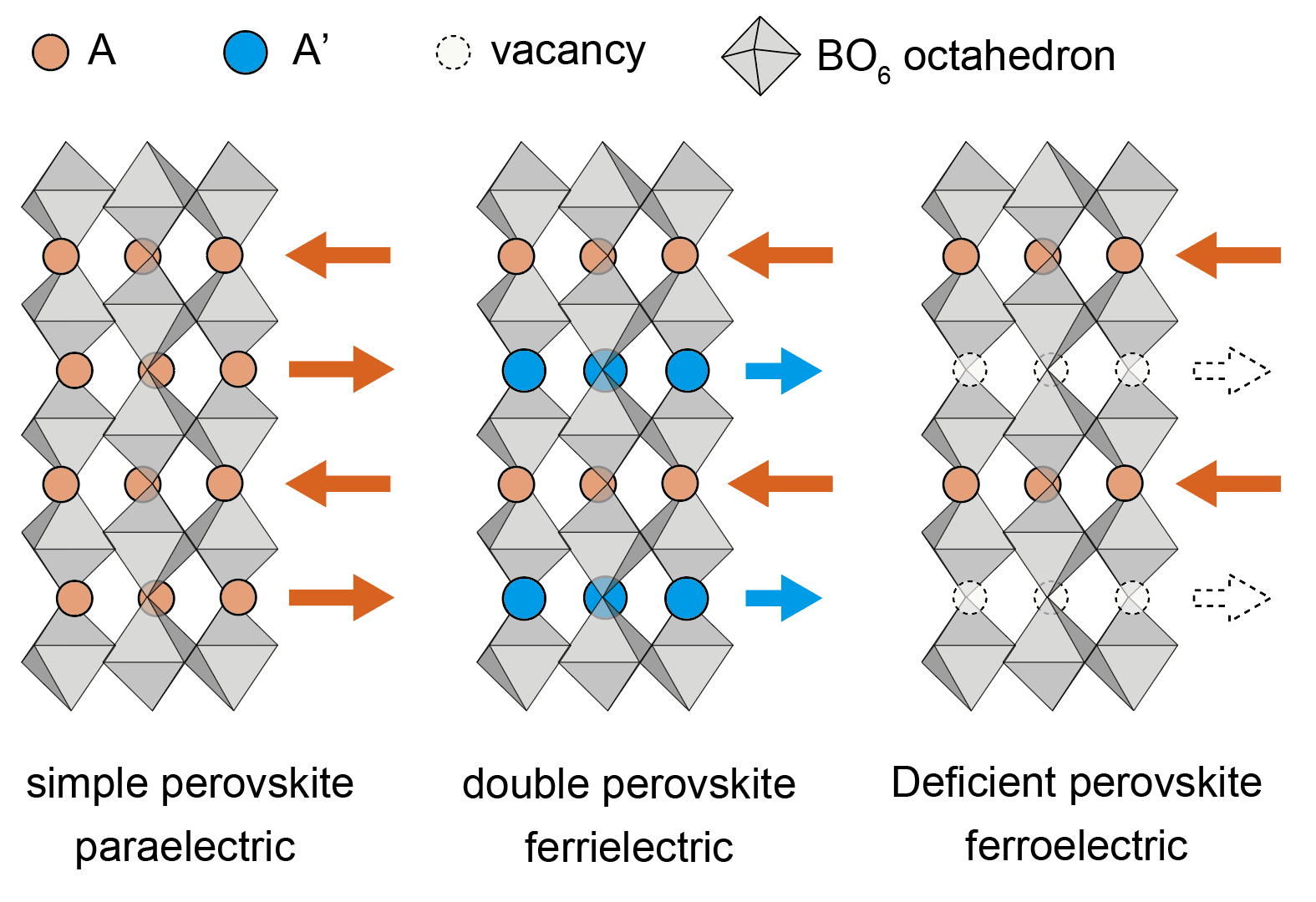 Switchable Polarization in an A-site Deficient Perovskite through Vacancy and Cation EngineeringSuguru Yoshida, Olivier Hernandez, Jinsuke Miyake, Kei Nakayama, Ryo Ishikawa, Hajime Hojo, Yuichi Ikuhara, Venkatraman Gopalan, Katsuhisa Tanaka, and Koji FujitaarXiv preprint, (2025).
Switchable Polarization in an A-site Deficient Perovskite through Vacancy and Cation EngineeringSuguru Yoshida, Olivier Hernandez, Jinsuke Miyake, Kei Nakayama, Ryo Ishikawa, Hajime Hojo, Yuichi Ikuhara, Venkatraman Gopalan, Katsuhisa Tanaka, and Koji FujitaarXiv preprint, (2025). - Cryst. Growth & Des.
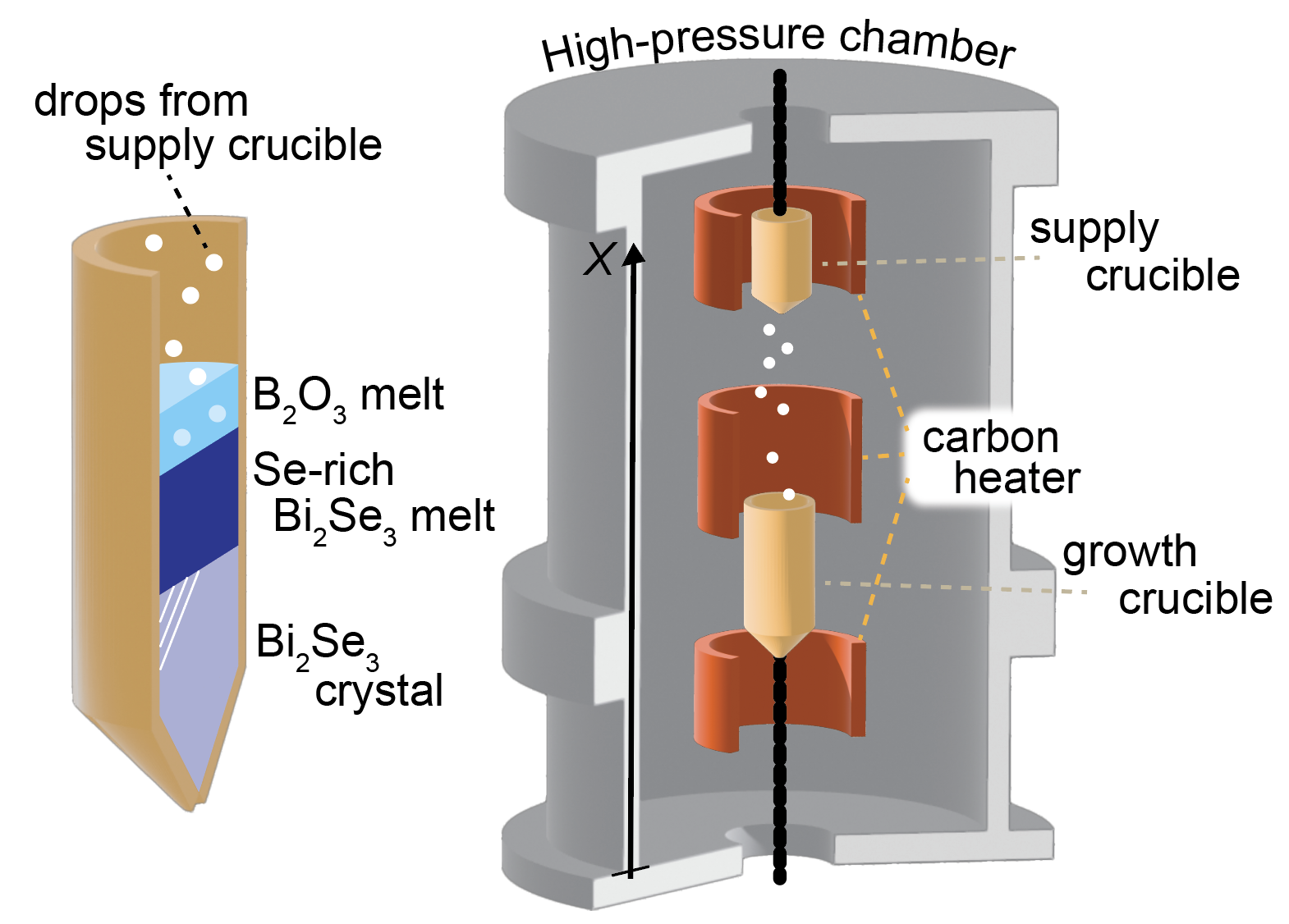 Double-Crucible Vertical Bridgman Technique for Stoichiometry-Controlled Chalcogenide Crystal GrowthYingdong Guan, Suguru Yoshida, Jairo Obando-Guevara, Seng Huat Lee, Heike Pfau, and Zhiqiang MaoCryst. Growth Des., 25 , 9333–9342 (2025).
Double-Crucible Vertical Bridgman Technique for Stoichiometry-Controlled Chalcogenide Crystal GrowthYingdong Guan, Suguru Yoshida, Jairo Obando-Guevara, Seng Huat Lee, Heike Pfau, and Zhiqiang MaoCryst. Growth Des., 25 , 9333–9342 (2025).We developed a double-crucible vertical Bridgman (DCVB) method enabling precise stoichiometric control in single-crystal growth. Applied to Bi₂Se₃, it yields carrier concentrations one to two orders lower than conventional methods, offering a new route to high-purity chalcogenide and pnictide crystals.
- Dalton Trans.
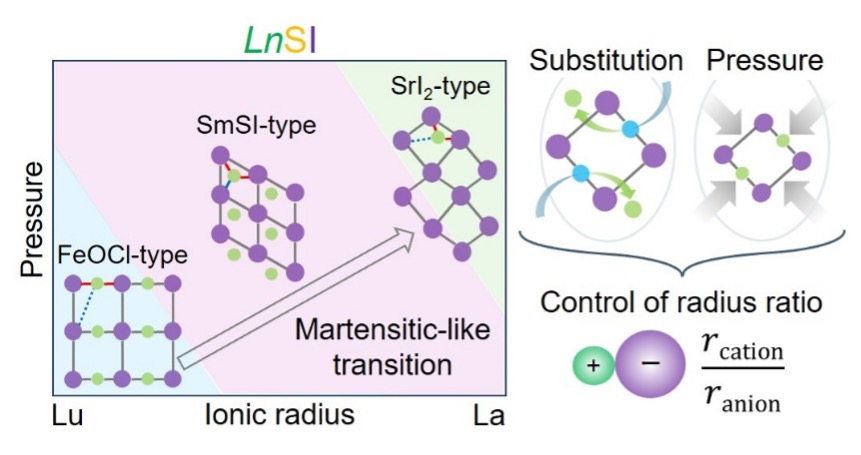 Structural stability and polymorphic transitions in LnSI (Ln = lanthanides)Shohei Kawanishi, Suguru Yoshida, Hiroki Ubukata, Congling Yin, Yang Yang, Ryusei Morimoto, Simon J. Clarke, and Hiroshi KageyamaDalton Trans., 54 , 10263–10269 (2025).
Structural stability and polymorphic transitions in LnSI (Ln = lanthanides)Shohei Kawanishi, Suguru Yoshida, Hiroki Ubukata, Congling Yin, Yang Yang, Ryusei Morimoto, Simon J. Clarke, and Hiroshi KageyamaDalton Trans., 54 , 10263–10269 (2025).Chemical substitution and physical pressure drive Martensitic-like polymorphic transitions among FeOCl-, SmSI-, and SrI2-type structures in LnSI mixed-anion compounds, governed by the cation-to-anion radius ratio as a unifying geometric factor.
- Sci. Adv.Large enhancement of ferroelectric properties of perovskite oxides via nitrogen incorporationTao Wang, Fenghui Gong, Xue Ma, Shen Pan, Xian-Kui Wei, Changyang Kuo, Suguru Yoshida, Yu-Chieh Ku, Shuai Wang, Zhenni Yang, Sankalpa Hazra, Kelvin H L Zhang, Xingjun Liu, Yunlong Tang, Yin-Lian Zhu, Chun-Fu Chang, Sujit Das, Xiuliang Ma, Lang Chen, Bin Xu, Venkatraman Gopalan, Laurent Bellaiche, Lane W Martin, and Zuhuang ChenSci. Adv., 11 , eads8830 (2025).
Perovskite oxides are attractive for devices like nonvolatile memory, but anion substitution remains underexplored due to synthesis challenges. We report nitrogen-incorporated BaTiO₃ thin films grown by reactive pulsed-laser deposition. Strong Ti–N hybridization yields a large polarization of 70 μC/cm² and a high Curie temperature of 1213 K: significantly exceeding those of bulk BaTiO₃. This highlights the potential of anion-substituted perovskites for novel functionalities.
@article{Wang2025SciAdv, title = {Large enhancement of ferroelectric properties of perovskite oxides via nitrogen incorporation}, author = {Wang, Tao and Gong, Fenghui and Ma, Xue and Pan, Shen and Wei, Xian-Kui and Kuo, Changyang and Yoshida, Suguru and Ku, Yu-Chieh and Wang, Shuai and Yang, Zhenni and Hazra, Sankalpa and Zhang, Kelvin H L and Liu, Xingjun and Tang, Yunlong and Zhu, Yin-Lian and Chang, Chun-Fu and Das, Sujit and Ma, Xiuliang and Chen, Lang and Xu, Bin and Gopalan, Venkatraman and Bellaiche, Laurent and Martin, Lane W and Chen, Zuhuang}, journal = {Sci. Adv.}, publisher = {American Association for the Advancement of Science (AAAS)}, volume = {11}, number = {2}, pages = eads8830, month = jan, year = {2025}, language = {en}, doi = {10.1126/sciadv.ads8830} } - Sci. Adv.Discovery of a layered multiferroic compound Cu1−xMn1+ySiTe3 with strong magnetoelectric couplingChandan De, Yu Liu, Sai Venkata Gayathri Ayyagari, Boyang Zheng, Kyle P Kelley, Sankalpa Hazra, Jingyang He, Sylwia Pawledzio, Subin Mali, Samaresh Guchaait, Suguru Yoshida, Yingdong Guan, Seng Huat Lee, Milos Sretenovic, Xianglin Ke, Le Wang, Mark H Engelhard, Yingge Du, Weiwei Xie, Xiaoping Wang, Vincent H Crespi, Nasim Alem, Venkatraman Gopalan, Qiang Zhang, and Zhiqiang MaoSci. Adv., 11 , eadp9379 (2025).
We report a multiferroic chalcogenide semiconductor,Cu1−xMn1+xSiTe3, with a polar monoclinic structure and canted antiferromagnetism below 35 K. Magnetoelectric measurements reveal strong coupling, with polarization up to 0.8 μC/cm² at 10 K, comparable to leading oxide multiferroics. Possible room-temperature ferroelectricity suggests this compound as a rare and promising chalcogenide multiferroic platform.
@article{De2025SciAdv, title = {Discovery of a layered multiferroic compound Cu<sub>1−<i>x</i></sub>Mn<sub>1+<i>y</i></sub>SiTe<sub>3</sub> with strong magnetoelectric coupling}, author = {De, Chandan and Liu, Yu and Ayyagari, Sai Venkata Gayathri and Zheng, Boyang and Kelley, Kyle P and Hazra, Sankalpa and He, Jingyang and Pawledzio, Sylwia and Mali, Subin and Guchaait, Samaresh and Yoshida, Suguru and Guan, Yingdong and Lee, Seng Huat and Sretenovic, Milos and Ke, Xianglin and Wang, Le and Engelhard, Mark H and Du, Yingge and Xie, Weiwei and Wang, Xiaoping and Crespi, Vincent H and Alem, Nasim and Gopalan, Venkatraman and Zhang, Qiang and Mao, Zhiqiang}, journal = {Sci. Adv.}, publisher = {American Association for the Advancement of Science (AAAS)}, volume = {11}, number = {1}, pages = eadp9379, month = jan, year = {2025}, language = {en}, doi = {10.1126/sciadv.adp9379} } - J. Mater. Chem. CStructural frustration effects by mixed alkali ions in ferroelectric Dion–Jacobson layered perovskites (Cs,Rb)NdNb2O7Zhen-Tao Lu, Sota Asaki, Suguru Yoshida, Chikako Moriyoshi, George Hasegawa, Koji Fujita, Venkatraman Gopalan, Katsuro Hayashi, and Hirofumi AkamatsuJ. Mater. Chem. C, 13 , 1812–1823 (2025).
We synthesized solid solutions of Dion–Jacobson layered perovskites (Cs,Rb)NdNb2O7 and mapped their temperature–composition phase diagram. All compositions show room-temperature ferroelectricity, driven by hybrid improper mechanisms involving coupled octahedral rotations. Structural analysis reveals a transition from P21am to I2cm space groups as Rb content increases. Intermediate compositions exhibit suppressed transition temperatures, indicating frustration from mixed alkali ions. These results clarify how interlayer cation choice affects structure and ferroelectricity in DJ perovskites.
@article{Lu2025JMCC, title = {Structural frustration effects by mixed alkali ions in ferroelectric Dion–Jacobson layered perovskites (Cs,Rb)NdNb<sub>2</sub>O<sub>7</sub>}, author = {Lu, Zhen-Tao and Asaki, Sota and Yoshida, Suguru and Moriyoshi, Chikako and Hasegawa, George and Fujita, Koji and Gopalan, Venkatraman and Hayashi, Katsuro and Akamatsu, Hirofumi}, journal = {J. Mater. Chem. C}, publisher = {Royal Society of Chemistry (RSC)}, volume = {13}, number = {4}, pages = {1812--1823}, month = jan, year = {2025}, language = {en}, doi = {10.1039/d4tc04190a} }
2024
- Chem. Mater.Zn2MnSbO6 and Zn2FeSbO6: Two new polar high-pressure ordered corundum-type compoundsAlessia Provino, Thomas J. Emge, David Walker, Corey E. Frank, Suguru Yoshida, Venkatraman Gopalan, Mark Croft, Zheng Deng, Changqing Jin, Pietro Manfrinetti, and Martha GreenblattChem. Mater., 36 , 11833–11851 (2024).
Two new oxides, Zn₂FeSbO₆ and Zn₂MnSbO₆, were synthesized by high-pressure technique and structurally characterized. Zn₂FeSbO₆ is a cocrystal of Ni₃TeO₆- and ilmenite-type motifs, while Zn₂MnSbO₆ contains two non-equivalent ilmenite-like components. XANES confirms Fe³⁺ and Mn³⁺ states. Zn₂MnSbO₆ is polar (R3) and SHG-active. Both compounds exhibit antiferromagnetic interactions with spin-glass behavior, with Néel temperatures of 9 K (Fe) and 4 K (Mn), and significant magnetic frustration, especially in the Mn compound.
@article{Provino2024CM, title = {Zn<sub>2</sub>MnSbO<sub>6</sub> and Zn<sub>2</sub>FeSbO<sub>6</sub>: Two new polar high-pressure ordered corundum-type compounds}, author = {Provino, Alessia and Emge, Thomas J. and Walker, David and Frank, Corey E. and Yoshida, Suguru and Gopalan, Venkatraman and Croft, Mark and Deng, Zheng and Jin, Changqing and Manfrinetti, Pietro and Greenblatt, Martha}, journal = {Chem. Mater.}, publisher = {American Chemical Society (ACS)}, volume = {36}, pages = {11833--11851}, month = dec, year = {2024}, language = {en}, doi = {10.1021/acs.chemmater.4c02146} } - Adv. Opt. Mater.Wide‐bandgap RBa3(B3O6)3 (R = Nd, Sm, Tb, Dy, and Er) single crystals for ultraviolet nonlinear opticsSaugata Sarker, Yu Wang, Caeli Benyacko, Yingdong Guan, Suguru Yoshida, Hemant Yennawar, Jingyang He, Zhiqiang Mao, and Venkatraman GopalanAdv. Opt. Mater., 12 , 2401437 (2024).
Rare-earth borates RBa₃(B₃O₆)₃ (R = Nd, Sm, Tb, Dy, Er) were grown by optical floating zone and found to be noncentrosymmetric, contrary to earlier reports. They exhibit direct bandgaps ( 5.6–5.7 eV), strong visible and mid-IR photoluminescence, and both Type-I and Type-II SHG phase matchability. DyBa₃(B₃O₆)₃ shows a high SHG coefficient (1.2 pm/V) and a laser damage threshold of 650–900 GW/cm²—much higher than β-BaB₂O₄. These properties highlight their potential for high-power laser and nonlinear optical applications.
@article{Sarker2024AOM, title = {Wide‐bandgap <i>R</i>Ba<sub>3</sub>(B<sub>3</sub>O<sub>6</sub>)<sub>3</sub> (<i>R</i> = Nd, Sm, Tb, Dy, and Er) single crystals for ultraviolet nonlinear optics}, author = {Sarker, Saugata and Wang, Yu and Benyacko, Caeli and Guan, Yingdong and Yoshida, Suguru and Yennawar, Hemant and He, Jingyang and Mao, Zhiqiang and Gopalan, Venkatraman}, journal = {Adv. Opt. Mater.}, publisher = {Wiley}, volume = {12}, number = {32}, pages = {2401437}, month = aug, year = {2024}, keywords = {borate; laser crystal; nonlinear optics; second harmonic generation}, language = {en}, doi = {10.1002/adom.202401437} } - PRBThermal expansion and phase stability of BF3 (B = Sc, Y, La, Al, Ga, In) from first principlesHiroki Koiso, Suguru Yoshida, Takayuki Nagai, Toshihiro Isobe, Akira Nakajima, and Yasuhide MochizukiPhys. Rev. B., 110 , 064104 (2024).
ScF₃ uniquely exhibits strong negative thermal expansion (NTE) over a wide temperature range, unmatched by other binary trifluorides. To understand this, ab initio molecular dynamics, lattice dynamics, and electronic structure analyses were performed on BF₃ (B = Sc, Y, La, Al, Ga, In). The study shows that octahedral rotational distortions (ORDs) in ScF₃ increase the frequency of the key phonon mode and weaken the NTE. Group theory and band-unfolding reveal that while several trifluorides are prone to ORDs via the second-order Jahn–Teller effect, only ScF₃ maintains a delicate balance to remain the non-distorted cubic symmetry, enabling stable NTE. These insights inform future design of NTE materials.
@article{Koiso2024PRB, title = {Thermal expansion and phase stability of <i>B</i>F<sub>3</sub> (<i>B</i> = Sc, Y, La, Al, Ga, In) from first principles}, author = {Koiso, Hiroki and Yoshida, Suguru and Nagai, Takayuki and Isobe, Toshihiro and Nakajima, Akira and Mochizuki, Yasuhide}, journal = {Phys. Rev. B.}, publisher = {American Physical Society (APS)}, volume = {110}, number = {6}, pages = {064104}, month = aug, year = {2024}, language = {en}, doi = {10.1103/PhysRevB.110.064104} } - Nat. Commun.
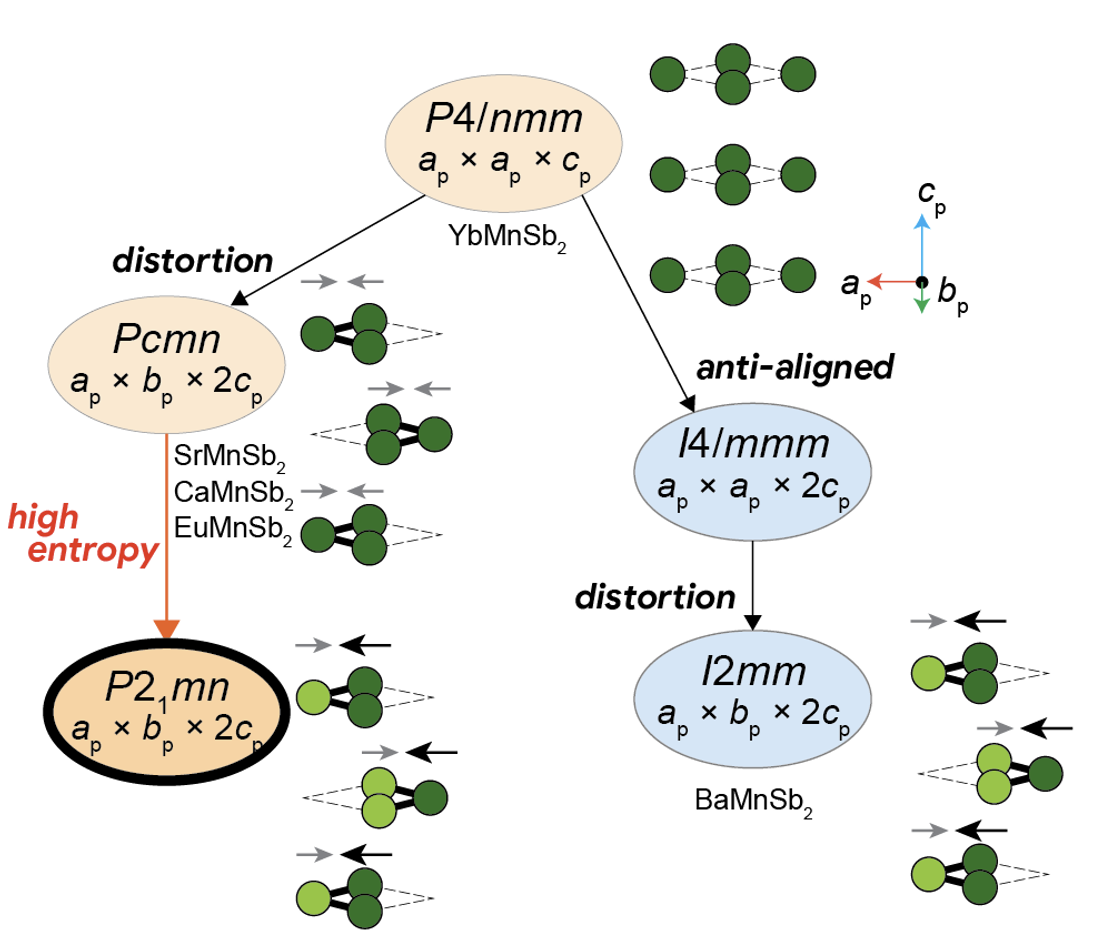 High-entropy engineering of the crystal and electronic structures in a Dirac materialAntu Laha, Suguru Yoshida, Francisco Santos Vieira, Hemian Yi, Seng Huat Lee, Sai Venkata Gayathri Ayyagari, Yingdong Guan, Lujin Min, Jose Gonzalez Jimenez, Leixin Miao, David Graf, Saugata Sarker, Weiwei Xie, Nasim Alem, Venkatraman Gopalan, Cui-Zu Chang, Ismaila Dabo, and Zhiqiang MaoNat. Commun., 15 , 3532 (2024).
High-entropy engineering of the crystal and electronic structures in a Dirac materialAntu Laha, Suguru Yoshida, Francisco Santos Vieira, Hemian Yi, Seng Huat Lee, Sai Venkata Gayathri Ayyagari, Yingdong Guan, Lujin Min, Jose Gonzalez Jimenez, Leixin Miao, David Graf, Saugata Sarker, Weiwei Xie, Nasim Alem, Venkatraman Gopalan, Cui-Zu Chang, Ismaila Dabo, and Zhiqiang MaoNat. Commun., 15 , 3532 (2024).A high-entropy strategy is used to engineer Dirac electronic states in topological materials. By mixing Ba, Sr, Ca, Eu, and Yb at the A site of AMnSb₂, a new compound (Ba0.38Sr0.14Ca0.16Eu0.16Yb0.16)MnSb₂ is synthesized with a polar structure absent in the parent phases. Despite lattice disorder, the high-entropy crystal retains linear band dispersion. Local distortions transform the original 2D Dirac states into anisotropic quasi-3D ones, as shown by quantum oscillation measurements. This work highlights high-entropy design as a promising route to tune structure and electronic properties in Dirac semimetals.
@article{Laha2024NC, title = {High-entropy engineering of the crystal and electronic structures in a Dirac material}, author = {Laha, Antu and Yoshida, Suguru and Marques dos Santos Vieira, Francisco and Yi, Hemian and Lee, Seng Huat and Ayyagari, Sai Venkata Gayathri and Guan, Yingdong and Min, Lujin and Gonzalez Jimenez, Jose and Miao, Leixin and Graf, David and Sarker, Saugata and Xie, Weiwei and Alem, Nasim and Gopalan, Venkatraman and Chang, Cui-Zu and Dabo, Ismaila and Mao, Zhiqiang}, journal = {Nat. Commun.}, publisher = {Nature Publishing Group}, volume = {15}, number = {1}, pages = {3532}, month = apr, year = {2024}, language = {en}, doi = {10.1038/s41467-024-47781-9} } - ACS Mater. Lett.NaMCl6 (M = Nb and Ta): A New Class of Sodium-Conducting Halide-Based Solid ElectrolytesZheng Huang, Suguru Yoshida, Hirofumi Akamatsu, Katsuro Hayashi, and Saneyuki OhnoACS Materials Lett., 6 , 1732–1738 (2024).
Halide-based Na-ion solid electrolytes remain underexplored compared to their Li counterparts. Here, we report enhanced ionic conductivity in NaM⁵⁺Cl₆ (M = Nb, Ta), derived from extending the structural motifs of known Na-ion halides like Na₃M³⁺Cl₆ and Na₂ZrCl₆. Transport analysis shows that the choice of M governs activation energy, and fine-tuning M yields a high conductivity of 0.1 mS/cm at 30 °C. These findings offer new directions for designing efficient Na-ion conducting halide electrolytes.
@article{Huang2024ACSML, title = {Na<i>M</i>Cl<sub>6</sub> (<i>M</i> = Nb and Ta): A New Class of Sodium-Conducting Halide-Based Solid Electrolytes}, author = {Huang, Zheng and Yoshida, Suguru and Akamatsu, Hirofumi and Hayashi, Katsuro and Ohno, Saneyuki}, journal = {ACS Materials Lett.}, publisher = {American Chemical Society}, volume = {6}, pages = {1732--1738}, month = apr, year = {2024}, doi = {10.1021/acsmaterialslett.4c00315} }
2023
- Opt. Mater. Exp.Computationally-driven discovery of second harmonic generation in EuBa₃(B₃O₆)₃ through centrosymmetry breakingJingyang He, Louis Alaerts, Yu Wang, Victor Trinquet, Suguru Yoshida, Hemant Yennawar, Victor Sanni, Romain Claes, Rowan Katzbaer, Evan Krysko, Saugata Sarker, Raymond Schaak, Gian-Marco Rignanese, Geoffroy Hautier, Zhiqiang Mao, and Venkatraman GopalanOpt. Mater. Express, 13 , 3416–3427 (2023).
We report the synthesis and characterization of EuBa₃(B₃O₆)₃, a rare-earth borate previously thought to be centrosymmetric. First-principles calculations and crystal growth reveal its true noncentrosymmetric P-6 structure, confirmed by second harmonic generation (SHG) measurements. The material shows a wide bandgap (5.56 eV), UV transparency down to 250 nm, and phase matchable SHG with d₁₁ ≈ 0.52 pm/V. This study highlights rare-earth borates as promising candidates for deep-UV nonlinear optical applications and demonstrates the power of computation-guided discovery.
@article{He2023OME, title = {Computationally-driven discovery of second harmonic generation in {EuBa₃}({B₃O₆})₃ through centrosymmetry breaking}, author = {He, Jingyang and Alaerts, Louis and Wang, Yu and Trinquet, Victor and Yoshida, Suguru and Yennawar, Hemant and Sanni, Victor and Claes, Romain and Katzbaer, Rowan and Krysko, Evan and Sarker, Saugata and Schaak, Raymond and Rignanese, Gian-Marco and Hautier, Geoffroy and Mao, Zhiqiang and Gopalan, Venkatraman}, journal = {Opt. Mater. Express}, publisher = {Optica Publishing Group}, volume = {13}, pages = {3416--3427}, month = oct, year = {2023}, language = {en}, doi = {10.1364/OME.497727} } - Adv. Opt. Mater.MgSiP2: An infrared nonlinear optical crystal with a large non‐resonant phase‐matchable second harmonic coefficient and high laser damage thresholdJingyang He, Yingdong Guan, Victor Trinquet, Guillaume Brunin, Ke Wang, Robert Robinson, Rui Zu, Suguru Yoshida, Seng Huat Lee, Yu Wang, Yanglin Zhu, Gian-Marco Rignanese, Zhiqiang Mao, and Venkatraman GopalanAdv. Opt. Mater., 11 , 2301060 (2023).
MgSiP₂ is a promising infrared nonlinear optical (NLO) crystal combining a high SHG coefficient (d₁₄ ≈ 89 pm/V at 1550 nm) with an exceptional laser damage threshold of 684 GW/cm², far exceeding leading NLO materials like ZnGeP₂. First-principles analysis attributes the strong response to the [SiP₄] tetrahedral units. MgSiP₂ also features a wide transparency range (0.53–10.35 μm) and supports both Type I and II phase matching, making it ideal for broadband IR frequency conversion.
@article{He2023AOM, title = {MgSiP<sub>2</sub>: An infrared nonlinear optical crystal with a large non‐resonant phase‐matchable second harmonic coefficient and high laser damage threshold}, author = {He, Jingyang and Guan, Yingdong and Trinquet, Victor and Brunin, Guillaume and Wang, Ke and Robinson, Robert and Zu, Rui and Yoshida, Suguru and Lee, Seng Huat and Wang, Yu and Zhu, Yanglin and Rignanese, Gian-Marco and Mao, Zhiqiang and Gopalan, Venkatraman}, journal = {Adv. Opt. Mater.}, publisher = {Wileyy}, volume = {11}, pages = {2301060}, month = jul, year = {2023}, language = {en}, doi = {10.1002/adom.20230106} } - J. Cryst. GrowthGrowth and phase transition of Sr3Zr2O7 single crystalsIkuya Fukasawa, Yuki Maruyama, Suguru Yoshida, Koji Fujita, Hidehiro Takahashi, Masataka Ohgaki, Masanori Nagao, Satoshi Watauchi, Venkatraman Gopalan, Katsuhisa Tanaka, and Isao TanakaJ. Cryst. Growth, 615 , 127241 (2023).
The hybrid improper ferroelectric Sr₃Zr₂O₇ was found to melt incongruently into SrZrO₃ and a liquid near 70 mol% SrO in the ZrO₂–SrO system. Using this insight, single crystals were successfully grown via the traveling solvent floating zone method with SrO-rich feed. Differential thermal analysis and SHG measurements confirmed a first-order ferroelectric phase transition at 410 °C, accompanied by orthorhombic twin domain reconstruction.
@article{Fukasawa2023JCG, title = {Growth and phase transition of Sr<sub>3</sub>Zr<sub>2</sub>O<sub>7</sub> single crystals}, author = {Fukasawa, Ikuya and Maruyama, Yuki and Yoshida, Suguru and Fujita, Koji and Takahashi, Hidehiro and Ohgaki, Masataka and Nagao, Masanori and Watauchi, Satoshi and Gopalan, Venkatraman and Tanaka, Katsuhisa and Tanaka, Isao}, journal = {J. Cryst. Growth}, volume = {615}, pages = {127241}, month = aug, year = {2023}, keywords = {A1. Phase diagrams; A2. Growth from melt; A2. Traveling solvent zone growth; A2. Single crystal growth; B1. Oxide}, doi = {10.1016/j.jcrysgro.2023.127241} } - JACSChemical Aspect of Displacive-Type Ferroaxial Phase Transition from Perspective of Second-Order Jahn-Teller Effect: NASICON Systems as an ExampleTakayuki Nagai, Yasuhide Mochizuki, Suguru Yoshida, and Tsuyoshi KimuraJ. Am. Chem. Soc., 145 , 8090–8098 (2023).
Ferroaxial order, involving rotational dipole arrangements, lacks clear design principles. We propose a chemical guideline based on staggered polyhedral connectivity and second-order Jahn–Teller (SOJT) interactions extended to band structures. NASICON compounds, such as NaM₂(PO₄)₃, emerge as promising candidates due to their staggered frameworks. First-principles calculations reveal that ferroaxial transitions occur only when SOJT interactions are symmetry-allowed, leading to stabilizing distortions. This framework offers a path to discovering new displacive-type ferroaxial materials beyond NASICON systems.
@article{Nagai2023JACS, title = {Chemical Aspect of Displacive-Type Ferroaxial Phase Transition from Perspective of Second-Order Jahn-Teller Effect: NASICON Systems as an Example}, author = {Nagai, Takayuki and Mochizuki, Yasuhide and Yoshida, Suguru and Kimura, Tsuyoshi}, journal = {J. Am. Chem. Soc.}, volume = {145}, number = {14}, pages = {8090--8098}, month = apr, year = {2023}, language = {en}, doi = {10.1021/jacs.3c00797} }
2022
- Inorg. Chem.Topochemical Synthesis of LiCoF3 with a High-Temperature LiNbO3-Type StructureYumi Matsuo, Yuko Matsukawa, Masahiro Kitakado, George Hasegawa, Suguru Yoshida, Ryoto Kubonaka, Yuya Yoshida, Tatsushi Kawasaki, Eiichi Kobayashi, Chikako Moriyoshi, Saneyuki Ohno, Koji Fujita, Katsuro Hayashi, and Hirofumi AkamatsuInorg. Chem., 61 , 11746–11756 (2022).
A new perovskite fluoride, LixCoF₃ (x ≈ 1), with a low tolerance factor (0.81), was synthesized via rapid room-temperature lithiation of ReO₃-type CoF₃ using organolithium reagents. Synchrotron XRD and SHG reveal a high-temperature LiNbO₃-type structure (R3̅c) with Li–Co antisite defects and A-site splitting, consistent with hybrid DFT predictions. XAS and bond valence analysis confirm Co²⁺. The compound undergoes a paramagnetic-to-antiferromagnetic transition at 36 K. This work introduces a low-temperature pathway to LiNbO₃-type fluorides.
@article{Matsuo2022IC, title = {Topochemical Synthesis of LiCoF<sub>3</sub> with a High-Temperature LiNbO<sub>3</sub>-Type Structure}, author = {Matsuo, Yumi and Matsukawa, Yuko and Kitakado, Masahiro and Hasegawa, George and Yoshida, Suguru and Kubonaka, Ryoto and Yoshida, Yuya and Kawasaki, Tatsushi and Kobayashi, Eiichi and Moriyoshi, Chikako and Ohno, Saneyuki and Fujita, Koji and Hayashi, Katsuro and Akamatsu, Hirofumi}, journal = {Inorg. Chem.}, volume = {61}, number = {30}, pages = {11746--11756}, month = aug, year = {2022}, language = {en}, doi = {10.1021/acs.inorgchem.2c01439} } - Chem. Mater.
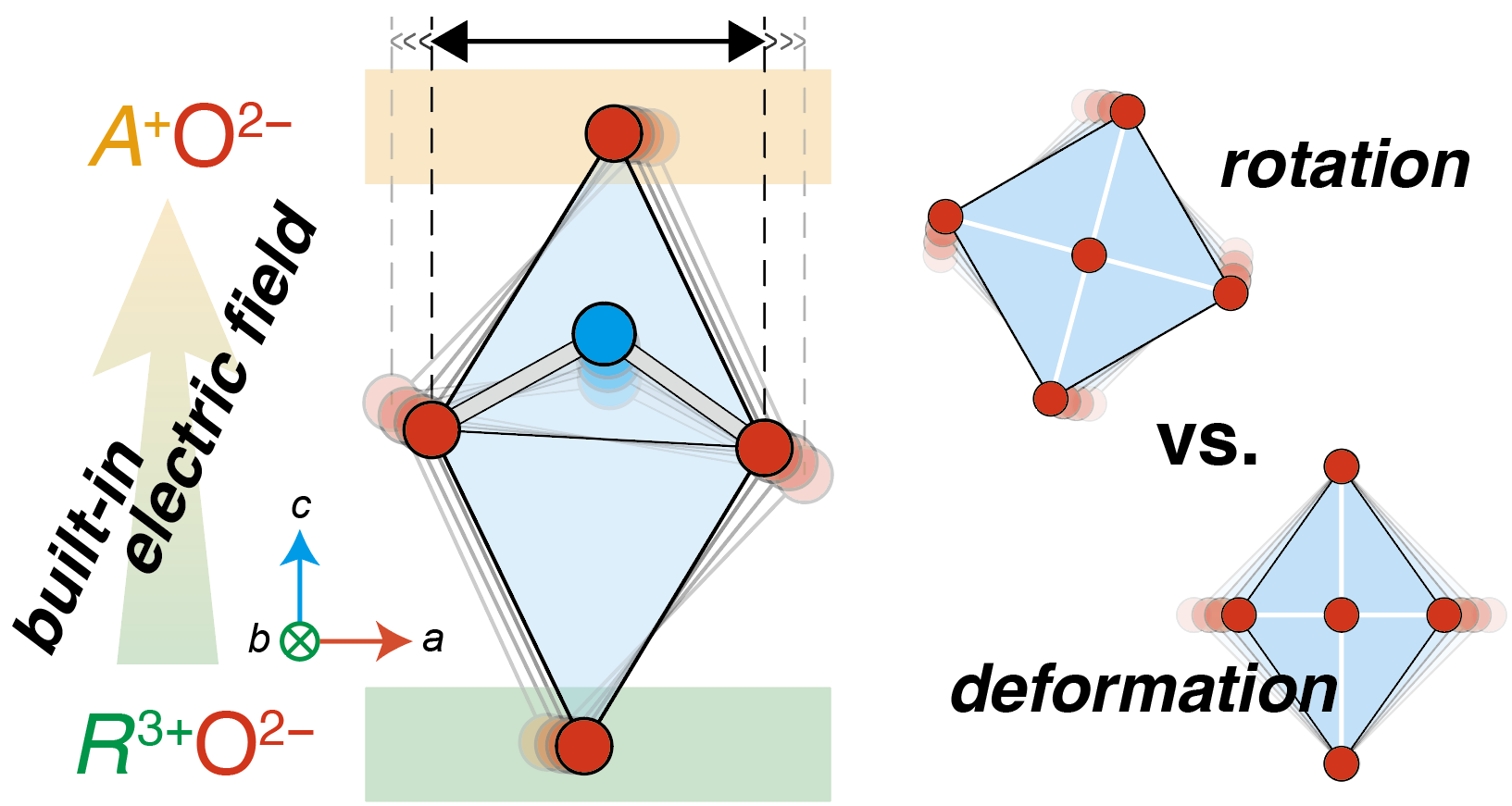 Interplay between Oxygen Octahedral Rotation and Deformation in the Acentric ARTiO4 Series toward Negative Thermal ExpansionSuguru Yoshida, Hirofumi Akamatsu, Alexandra S. Gibbs, Shogo Kawaguchi, Venkatraman Gopalan, Katsuhisa Tanaka, and Koji FujitaChem. Mater., 34 , 6492–6504 (2022).
Interplay between Oxygen Octahedral Rotation and Deformation in the Acentric ARTiO4 Series toward Negative Thermal ExpansionSuguru Yoshida, Hirofumi Akamatsu, Alexandra S. Gibbs, Shogo Kawaguchi, Venkatraman Gopalan, Katsuhisa Tanaka, and Koji FujitaChem. Mater., 34 , 6492–6504 (2022).In layered perovskites AgRTiO₄ (R = rare earth), biaxial negative thermal expansion (NTE) arises from the interplay between TiO₆ octahedral rotations and deformations, a mechanism distinct from conventional NTE materials. Contrary to previous reports, AgRTiO₄ adopts a noncentrosymmetric tetragonal (P4̅2₁m) structure, driven by specific octahedral rotation modes. Structural analysis reveals that reduced rotation amplitude upon heating induces out-of-plane elongation and in-plane compression of TiO₆ octahedra, causing shrinkage of lattice parameters a and b. The built-in electric field from Ag⁺–R³⁺ ordering promotes Ti⁴⁺ off-centering, stabilizing this unusual distortion coupling. Ag–O–Ti covalency enhances the deformation, explaining why biaxial NTE is absent in Na analogs. This work illustrates how competing octahedral distortions can be harnessed for functional control.
@article{Yoshida2022CM, title = {Interplay between Oxygen Octahedral Rotation and Deformation in the Acentric <i>AR</i>TiO<sub>4</sub> Series toward Negative Thermal Expansion}, author = {Yoshida, Suguru and Akamatsu, Hirofumi and Gibbs, Alexandra S. and Kawaguchi, Shogo and Gopalan, Venkatraman and Tanaka, Katsuhisa and Fujita, Koji}, journal = {Chem. Mater.}, publisher = {American Chemical Society}, volume = {34}, number = {14}, pages = {6492--6504}, month = jul, year = {2022}, doi = {10.1021/acs.chemmater.2c01245} } - Chem. Mater.Controlling Defects to Achieve Reproducibly High Ionic Conductivity in Na3SbS4 Solid ElectrolytesMasaki Shimoda, Mayu Maegawa, Suguru Yoshida, Hirofumi Akamatsu, Katsuro Hayashi, Prashun Gorai, and Saneyuki OhnoChem. Mater., 34 , 5634–5643 (2022).
Variations in ionic conductivity of Na₃SbS₄ solid electrolytes arise from uncontrolled elemental chemical potentials. Using theory and experiments, we show that precise control of these potentials—achieved via phase boundary mapping—reduces sample-to-sample variation from 50% to 15%, yielding consistently high conductivity ( 0.94 mS/cm). This work reveals the role of hidden thermodynamic states in determining SE performance and underscores the importance of chemical potential control for reproducibility.
@article{Shimoda2022CM, title = {Controlling Defects to Achieve Reproducibly High Ionic Conductivity in Na<sub>3</sub>SbS<sub>4</sub> Solid Electrolytes}, author = {Shimoda, Masaki and Maegawa, Mayu and Yoshida, Suguru and Akamatsu, Hirofumi and Hayashi, Katsuro and Gorai, Prashun and Ohno, Saneyuki}, journal = {Chem. Mater.}, publisher = {American Chemical Society}, volume = {34}, number = {12}, pages = {5634--5643}, month = jun, year = {2022}, doi = {10.1021/acs.chemmater.2c00944} }
2021
- PRL
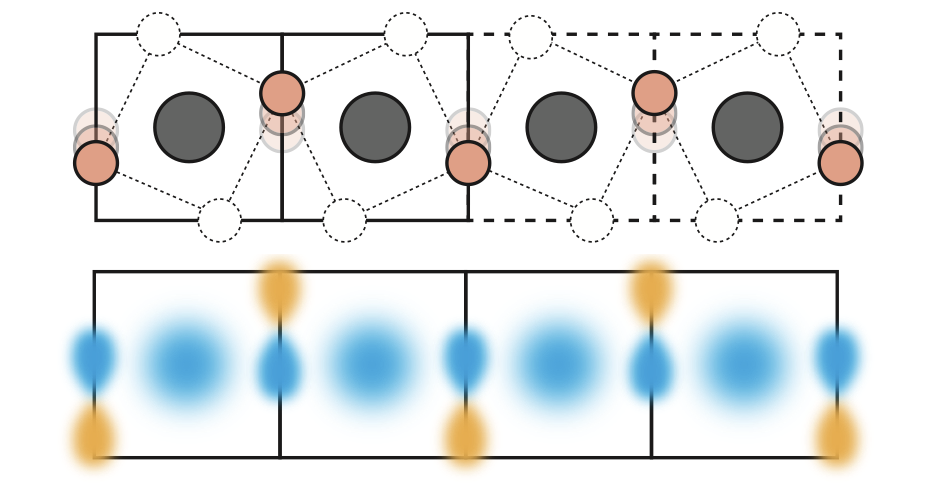 Electronic Origin of Non-Zone-Center Phonon Condensation: Octahedral Rotation as a Case StudySuguru Yoshida, Hirofumi Akamatsu, and Katsuro HayashiPhys. Rev. Lett., 127 , 215701 (2021).
Electronic Origin of Non-Zone-Center Phonon Condensation: Octahedral Rotation as a Case StudySuguru Yoshida, Hirofumi Akamatsu, and Katsuro HayashiPhys. Rev. Lett., 127 , 215701 (2021).Zone-boundary phonon modes drive structural distortions linked to functional properties, but their quantum-mechanical origin has remained unclear. This study proposes that bonding interactions between Bloch states at different wave vectors cause these instabilities via the second-order Jahn–Teller effect. First-principles calculations and group-theoretical analysis demonstrate that classic octahedral rotations result from this mechanism. The proposed framework applies broadly to non-zone-center phonon condensations and offers a unified perspective on structural phase transitions in crystalline materials.
@article{Yoshida2021PRL, title = {Electronic Origin of Non-Zone-Center Phonon Condensation: Octahedral Rotation as a Case Study}, author = {Yoshida, Suguru and Akamatsu, Hirofumi and Hayashi, Katsuro}, journal = {Phys. Rev. Lett.}, volume = {127}, number = {21}, pages = {215701}, month = nov, year = {2021}, language = {en}, doi = {10.1103/PhysRevLett.127.215701}, }
2020
- JJAPFerroelectricity of Dion-Jacobson layered perovskites CsNdNb2O7 and RbNdNb2O7Sota Asaki, Hirofumi Akamatsu, George Hasegawa, Tomohiro Abe, Yuki Nakahira, Suguru Yoshida, Chikako Moriyoshi, and Katsuro HayashiJpn. J. Appl. Phys., 59 , SPPC04 (2020).
Dense polycrystalline CsNdNb₂O₇ and RbNdNb₂O₇ exhibit room-temperature ferroelectricity with clear polarization hysteresis, confirming the hybrid improper ferroelectric mechanism driven by coupled octahedral rotations. Remanent polarizations of 2–3 μC/cm² exceed those of previously reported polycrystalline hybrid improper ferroelectrics. CsNdNb₂O₇ shows a dielectric anomaly at 625 K, marking the ferroelectric transition, while RbNdNb₂O₇ retains polar symmetry without anomalies up to 773 K, consistent with prior diffraction results.
@article{Asaki2020-kl, title = {Ferroelectricity of Dion-Jacobson layered perovskites CsNdNb<sub>2</sub>O<sub>7</sub> and RbNdNb<sub>2</sub>O<sub>7</sub>}, author = {Asaki, Sota and Akamatsu, Hirofumi and Hasegawa, George and Abe, Tomohiro and Nakahira, Yuki and Yoshida, Suguru and Moriyoshi, Chikako and Hayashi, Katsuro}, journal = {Jpn. J. Appl. Phys.}, volume = {59}, pages = {SPPC04}, year = {2020}, doi = {10.35848/1347-4065/abad46}, }
2018
- JACS
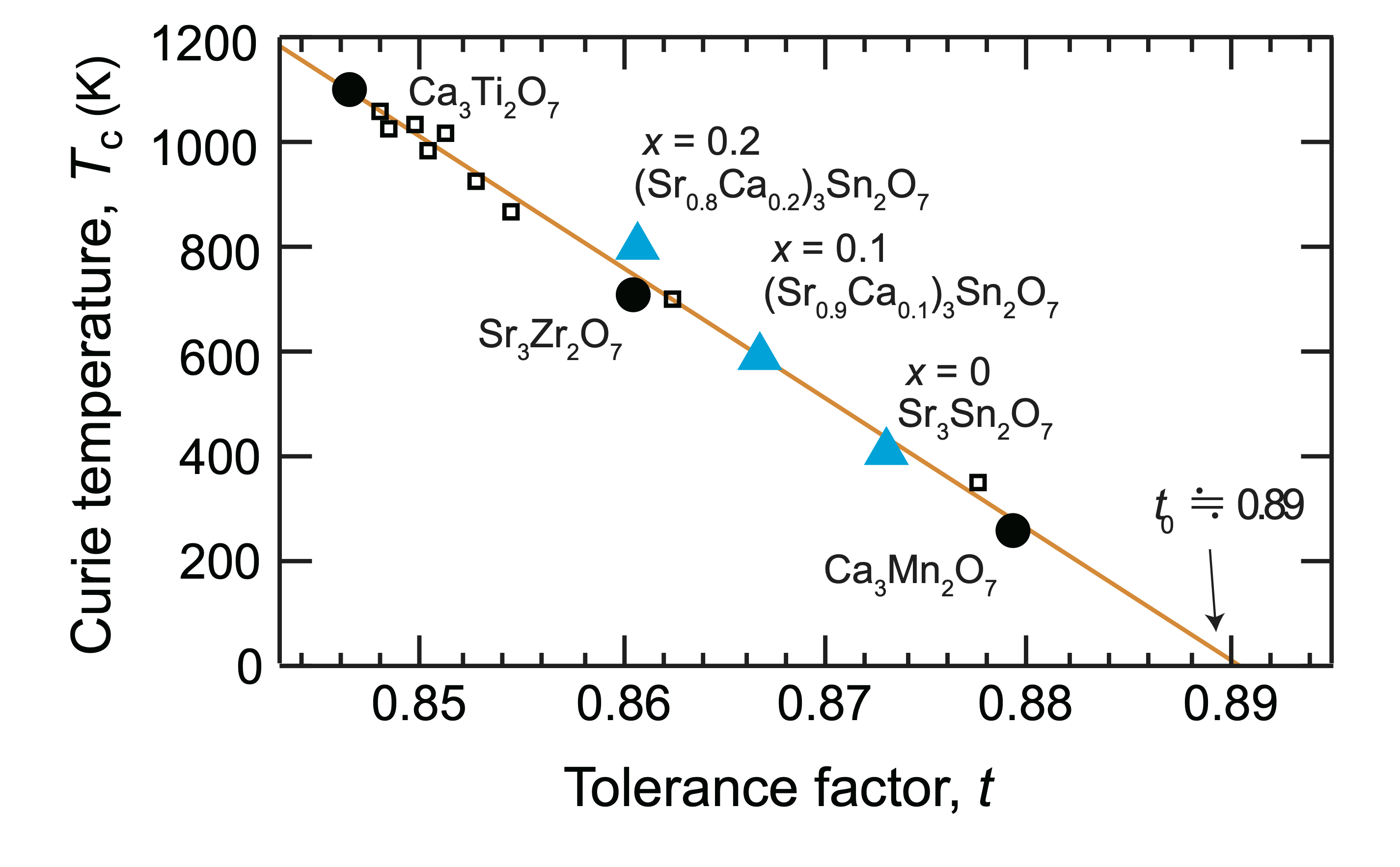 Hybrid Improper Ferroelectricity in (Sr,Ca)3Sn2O7 and Beyond: Universal Relationship between Ferroelectric Transition Temperature and Tolerance Factor in n = 2 Ruddlesden-Popper PhasesSuguru Yoshida, Hirofumi Akamatsu, Ryosuke Tsuji, Olivier Hernandez, Haricharan Padmanabhan, Arnab Sen Gupta, Alexandra S. Gibbs, Ko Mibu, Shunsuke Murai, James M. Rondinelli, Venkatraman Gopalan, Katsuhisa Tanaka, and Koji FujitaJ. Am. Chem. Soc., 140 , 15690–15700 (2018).
Hybrid Improper Ferroelectricity in (Sr,Ca)3Sn2O7 and Beyond: Universal Relationship between Ferroelectric Transition Temperature and Tolerance Factor in n = 2 Ruddlesden-Popper PhasesSuguru Yoshida, Hirofumi Akamatsu, Ryosuke Tsuji, Olivier Hernandez, Haricharan Padmanabhan, Arnab Sen Gupta, Alexandra S. Gibbs, Ko Mibu, Shunsuke Murai, James M. Rondinelli, Venkatraman Gopalan, Katsuhisa Tanaka, and Koji FujitaJ. Am. Chem. Soc., 140 , 15690–15700 (2018).Hybrid improper ferroelectricity, driven by octahedral rotations, offers a promising pathway for discovering new ferroelectrics. While group theory and first-principles methods aid in structural predictions, they often fall short in estimating key parameters like the Curie temperature (TC). Using (Sr1−xCaₓ)₃Sn₂O₇ as a model system, we establish a clear, linear relationship between TC and the Goldschmidt tolerance factor t, purely calculated from ionic size. This correlation extends across known A₃B₂O₇ hybrid improper ferroelectrics, offering a simple, predictive tool for TC based on crystal chemistry.
@article{Yoshida2018JACS, title = {Hybrid Improper Ferroelectricity in (Sr,Ca)<sub>3</sub>Sn<sub>2</sub>O<sub>7</sub> and Beyond: Universal Relationship between Ferroelectric Transition Temperature and Tolerance Factor in <i>n</i> = 2 Ruddlesden-Popper Phases}, author = {Yoshida, Suguru and Akamatsu, Hirofumi and Tsuji, Ryosuke and Hernandez, Olivier and Padmanabhan, Haricharan and Sen Gupta, Arnab and Gibbs, Alexandra S. and Mibu, Ko and Murai, Shunsuke and Rondinelli, James M. and Gopalan, Venkatraman and Tanaka, Katsuhisa and Fujita, Koji}, journal = {J. Am. Chem. Soc.}, volume = {140}, number = {46}, pages = {15690--15700}, month = nov, year = {2018}, language = {en}, doi = {10.1021/jacs.8b07998} } - Adv. Funct. Mater.
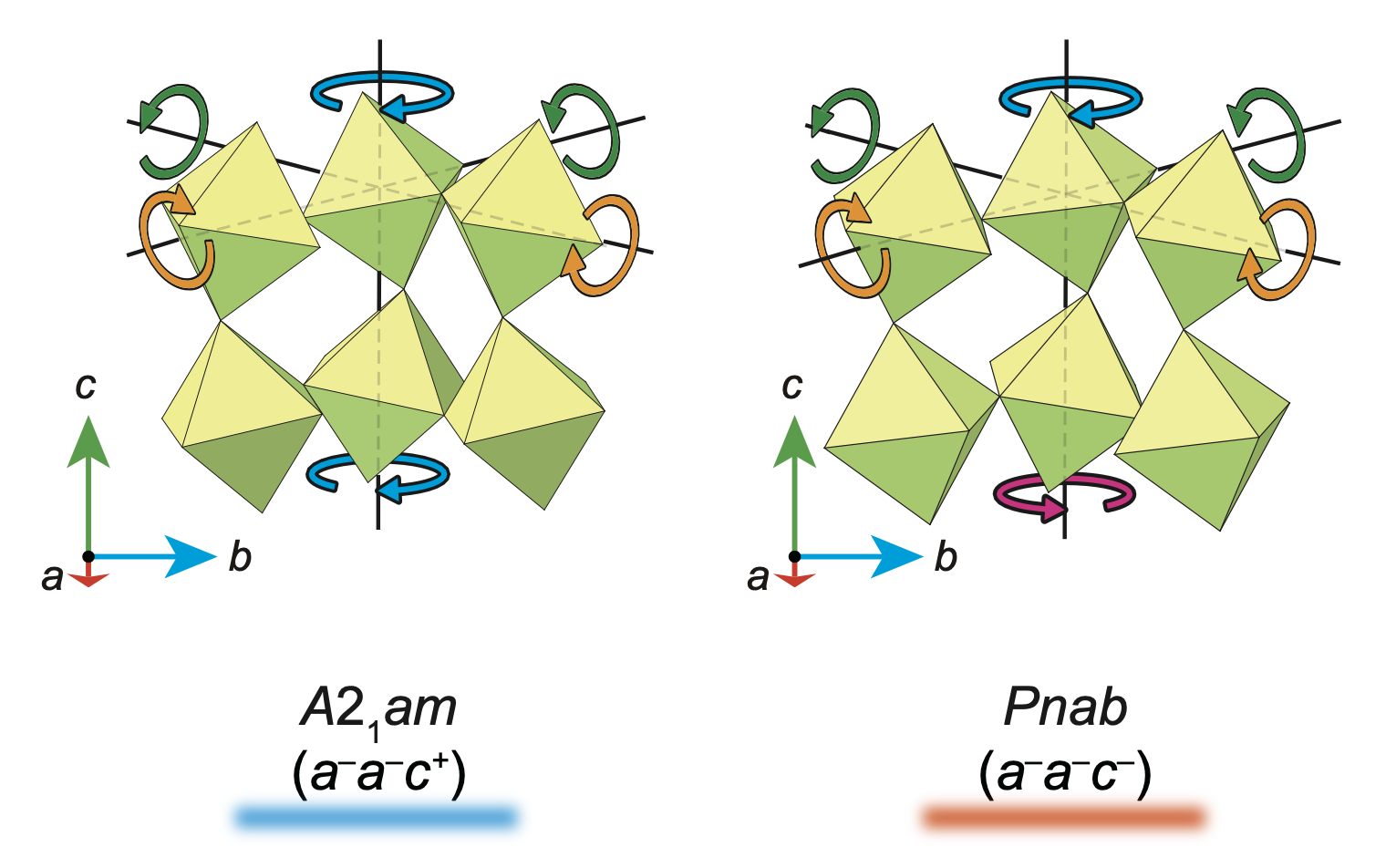 Ferroelectric Sr3Zr2O7 : Competition between hybrid improper ferroelectric and antiferroelectric mechanismsSuguru Yoshida, Koji Fujita, Hirofumi Akamatsu, Olivier Hernandez, Arnab Sen Gupta, Forrest G. Brown, Haricharan Padmanabhan, Alexandra S. Gibbs, Toshihiro Kuge, Ryosuke Tsuji, Shunsuke Murai, James M. Rondinelli, Venkatraman Gopalan, and Katsuhisa TanakaAdv. Funct. Mater., 28 , 1801856 (2018).
Ferroelectric Sr3Zr2O7 : Competition between hybrid improper ferroelectric and antiferroelectric mechanismsSuguru Yoshida, Koji Fujita, Hirofumi Akamatsu, Olivier Hernandez, Arnab Sen Gupta, Forrest G. Brown, Haricharan Padmanabhan, Alexandra S. Gibbs, Toshihiro Kuge, Ryosuke Tsuji, Shunsuke Murai, James M. Rondinelli, Venkatraman Gopalan, and Katsuhisa TanakaAdv. Funct. Mater., 28 , 1801856 (2018).Even nonpolar anion rotations can induce ferroelectricity via the hybrid improper ferroelectric (HIF) mechanism. Here, Sr₃Zr₂O₇ is reported as the first lead-free ternary zirconate HIF, showing room-temperature polarization switching. It undergoes a first-order transition involving a reversal in octahedral rotation sense, while tilt remains constant. Experiments and first-principles calculations reveal that the competing paraelectric phase arises from trilinear coupling with an antipolar mode, an interaction previously theorized but not observed. This highlights the role of anharmonic lattice interactions in designing new ferroelectrics and thermoelectrics.
@article{Yoshida2018AFM, title = {Ferroelectric Sr<sub>3</sub>Zr<sub>2</sub>O<sub>7</sub> : Competition between hybrid improper ferroelectric and antiferroelectric mechanisms}, author = {Yoshida, Suguru and Fujita, Koji and Akamatsu, Hirofumi and Hernandez, Olivier and Sen Gupta, Arnab and Brown, Forrest G. and Padmanabhan, Haricharan and Gibbs, Alexandra S. and Kuge, Toshihiro and Tsuji, Ryosuke and Murai, Shunsuke and Rondinelli, James M. and Gopalan, Venkatraman and Tanaka, Katsuhisa}, journal = {Adv. Funct. Mater.}, publisher = {Wiley}, volume = {28}, number = {30}, pages = {1801856}, month = jul, year = {2018}, language = {en}, doi = {10.1002/adfm.201801856} }
2017
- Inorg. Chem.Perovskite-Type InCoO3 with Low-Spin Co3+ : Effect of In–O Covalency on Structural Stabilization in Comparison with Rare-Earth SeriesKoji Fujita, Takahiro Kawamoto, Ikuya Yamada, Olivier Hernandez, Hirofumi Akamatsu, Yu Kumagai, Fumiyasu Oba, Pascal Manuel, Ryo Fujikawa, Suguru Yoshida, Masayuki Fukuda, and Katsuhisa TanakaInorg. Chem., 56 , 11113–11122 (2017).
A new perovskite cobaltite, InCoO3, was synthesized via high-pressure and high-temperature treatment at 15 GPa and 1450 °C. It crystallizes in the Pnma space group and exhibits diamagnetism with a low-spin state of Co3+ below 300 K. Comprehensive structural studies on newly developed and well-known Pnma ACoO3 perovskites (A = Sc, In, Y, Pr−Lu) highlight the role of In−O covalent bonding in InCoO3 with respect to stabilization of the orthorohombic perovskite structure.
@article{Fujita2017IC, title = {Perovskite-Type InCoO<sub>3</sub> with Low-Spin Co<sup>3+</sup> : Effect of {In–O} Covalency on Structural Stabilization in Comparison with Rare-Earth Series}, author = {Fujita, Koji and Kawamoto, Takahiro and Yamada, Ikuya and Hernandez, Olivier and Akamatsu, Hirofumi and Kumagai, Yu and Oba, Fumiyasu and Manuel, Pascal and Fujikawa, Ryo and Yoshida, Suguru and Fukuda, Masayuki and Tanaka, Katsuhisa}, journal = {Inorg. Chem.}, volume = {56}, number = {18}, pages = {11113--11122}, month = sep, year = {2017}, doi = {10.1021/acs.inorgchem.7b01426} } - Chem. Mater.Competing Structural Instabilities in the Ruddlesden–Popper Derivatives HRTiO4 (R = Rare Earths): Oxygen Octahedral Rotations Inducing Noncentrosymmetricity and Layer Sliding Retaining CentrosymmetricityArnab Sen Gupta, Hirofumi Akamatsu, Forrest G. Brown, Minh An T. Nguyen, Megan E Strayer, Saul Lapidus, Suguru Yoshida, Koji Fujita, Katsuhisa Tanaka, Isao Tanaka, Thomas E. Mallouk, and Venkatraman GopalanChem. Mater., 29 , 656–665 (2017).
Noncentrosymmetricity was identified in HRTiO₄ (R = Eu, Gd, Dy) layered oxides using second harmonic generation, synchrotron X-ray diffraction, and DFT calculations. Though previously thought to be centrosymmetric, inversion symmetry is broken by octahedral rotations. A competition is observed between these rotations and sliding of structural blocks at the proton layers. Smaller R ions (Eu, Gd, Dy) favor rotation and show noncentrosymmetricity, while larger ions (Nd, Sm) favor sliding, preserving inversion symmetry. This reveals a rare-earth-size-dependent mechanism for controlling symmetry in layered oxides.
@article{Gupta2017CM, title = {Competing Structural Instabilities in the {Ruddlesden–Popper} Derivatives HRTiO<sub>4</sub> ({R} = Rare Earths): Oxygen Octahedral Rotations Inducing Noncentrosymmetricity and Layer Sliding Retaining Centrosymmetricity}, author = {Sen Gupta, Arnab and Akamatsu, Hirofumi and Brown, Forrest G. and Nguyen, Minh An T. and Strayer, Megan E and Lapidus, Saul and Yoshida, Suguru and Fujita, Koji and Tanaka, Katsuhisa and Tanaka, Isao and Mallouk, Thomas E. and Gopalan, Venkatraman}, journal = {Chem. Mater.}, volume = {29}, number = {2}, pages = {656--665}, month = jan, year = {2017}, doi = {10.1021/acs.chemmater.6b04103} }
2016
- JSSCStructural phase transitions in EuNbO3 perovskiteYoshiro Kususe, Suguru Yoshida, Koji Fujita, Hirofumi Akamatsu, Masafumi Fukuzumi, Shunsuke Murai, and Katsuhisa TanakaJ. Solid State Chem., 239 , 192–199 (2016).
Synchrotron X-ray diffraction reveals two structural phase transitions in EuNbO₃ between 20 and 500 K. Below 350 K, it adopts an orthorhombic Imma structure with NbO₆ octahedral tilting. At 360 K, a first-order transition occurs to a tetragonal I4/mcm phase, followed by a continuous transition to the cubic Pm3̅m phase at 460 K. These findings revise previous reports that assigned a cubic structure to EuNbO₃ at room temperature.
@article{Kususe2016JSSC, title = {Structural phase transitions in EuNbO<sub>3</sub> perovskite}, author = {Kususe, Yoshiro and Yoshida, Suguru and Fujita, Koji and Akamatsu, Hirofumi and Fukuzumi, Masafumi and Murai, Shunsuke and Tanaka, Katsuhisa}, journal = {J. Solid State Chem.}, volume = {239}, pages = {192--199}, year = {2016}, doi = {10.1016/j.jssc.2016.04.032} } - JACSTopochemical Nitridation with Anion Vacancy-Assisted N3− / O2− Exchange"Riho Mikita, Tomoko Aharen, Takafumi Yamamoto, Fumitaka Takeiri, Tang Ya, Wataru Yoshimune, Koji Fujita, Suguru Yoshida, Katsuhisa Tanaka, Dmitry Batuk, Artem M. Abakumov, Craig M. Brown, Yoji Kobayashi, and Hiroshi KageyamaJ. Am. Chem. Soc., 138 , 3211–3217 (2016).
We demonstrate that anion vacancies in perovskite oxyhydride EuTiO3−xHx (x ≈ 0.18) facilitate low-temperature ammonolysis, enabling access to new oxynitrides. At 400 °C, hydride mobility promotes N³⁻/H⁻ exchange, yielding EuTiO₂.₈₂N₀.₁₂□₀.₀₆. At 800 °C, further nitridation produces fully oxidized Eu³⁺Ti⁴⁺O₂N with a metastable Pnma structure. In contrast, starting from EuTiO₃ oxide leads to incomplete nitridation below 600 °C. These results highlight how hydride-induced anion vacancies promote efficient N³⁻/O²⁻ exchange, broadening the design space for perovskite oxynitrides.
@article{Mikita2016JACS, title = {Topochemical Nitridation with Anion Vacancy-Assisted N<sup>3−</sup> / O<sup>2−</sup> Exchange"}, author = {Mikita, Riho and Aharen, Tomoko and Yamamoto, Takafumi and Takeiri, Fumitaka and Ya, Tang and Yoshimune, Wataru and Fujita, Koji and Yoshida, Suguru and Tanaka, Katsuhisa and Batuk, Dmitry and Abakumov, Artem M. and Brown, Craig M. and Kobayashi, Yoji and Kageyama, Hiroshi}, journal = {J. Am. Chem. Soc.}, volume = {138}, number = {9}, pages = {3211--3217}, month = mar, year = {2016}, doi = {10.1021/jacs.6b00088} }